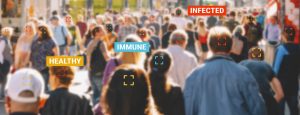News about the Covid 19 virus has become a ubiquitous backdrop in our lives, and the media’s frenzy in our lives has become more ubiquitous than the trappings  of the disease itself. More than masks and people side-eying while they avoid others, Covid news either placates or terrifies, although much of it is rhetorical rather than substantive, at least in the way that it is conveyed.
of the disease itself. More than masks and people side-eying while they avoid others, Covid news either placates or terrifies, although much of it is rhetorical rather than substantive, at least in the way that it is conveyed.
With each media source competing for our attention, the Covid stories either tend toward the outlandish—think of Trump’s advice about mainlining antiseptic—or garden variety fearmongering. More recently, perhaps recent work on the virus’ inner workings is understandably slow, our media has begun to play a blame game. It has become fashionable to blame the ponderous steps of governments, the intrusion into our bubbles of foreigners, or young people.
I am sure most people are familiar with the headlines about young people going on spring break,  for the sept-and-octogenarians everywhere were horrified that youth might return with the virus. Many Canadian news stories proclaimed that new cases were predominantly amongst young people, and some headlines even gleefully featured the single and unfortunate death of a man who was nineteen. Without much information about the poor man’s co-morbidities, the headlines continued claiming that young people everywhere were partying too much while Rome burned, and there was much discussion about how the younger generation cared about nothing:
for the sept-and-octogenarians everywhere were horrified that youth might return with the virus. Many Canadian news stories proclaimed that new cases were predominantly amongst young people, and some headlines even gleefully featured the single and unfortunate death of a man who was nineteen. Without much information about the poor man’s co-morbidities, the headlines continued claiming that young people everywhere were partying too much while Rome burned, and there was much discussion about how the younger generation cared about nothing:
Dr. Prabhat Jha, a professor of global health in the University of Toronto’s faculty of medicine, said the demographics of COVID-19 have shifted nationwide, with new cases being driven primarily by people aged 20 to 39.
“The current sets of new infections, right throughout the country, are occurring in younger people. The vast majority are below age 40,” he said. “That’s attributable to close contacts, particularly in parties or in indoor spaces without distancing or masks.” (https://www.cbc.ca/news/canada/manitoba/covid-19-close-contacts-rising-manitoba-1.5734420)
Not surprisingly, this type of boomer talk sells news, for boomers make up most of the audience of the major media outlets, but such statements obscure the situation of people under forty. They make up half the population in Canada (https://www150.statcan.gc.ca/t1/tbl1/en/tv.action?pid=1710000501) and they are predominantly the working population of the country. They are the essential workers, or, as in the case for many of them, they are too poverty stricken to stay at home while their bank account dwindles.
Occasionally a news story will put a new spin on how it blames young people for the persistence of the virus. Desperate to elicit views, they have recently  began to explain an increase in recent cases—ignoring the reopening of schools—as people not isolating enough. The news story which caught my attention, however, was one which contrasted two very different pieces of information about the relative size of social groups in the early days of the pandemic with a more recent number. Momentarily forgetting that the many news stories quoting the WHO or CDC, or Marc Lipsitch, professor of epidemiology at the Harvard T.H. Chan School of Public Health (https://www.ama-assn.org/delivering-care/public-health/harvard-epidemiologist-beware-covid-19-s-second-wave-fall), who warned that an uptick in cases would likely arrive with the cooler weather, people in general are currently portrayed as careless by comparison of our earlier more timid selves:
began to explain an increase in recent cases—ignoring the reopening of schools—as people not isolating enough. The news story which caught my attention, however, was one which contrasted two very different pieces of information about the relative size of social groups in the early days of the pandemic with a more recent number. Momentarily forgetting that the many news stories quoting the WHO or CDC, or Marc Lipsitch, professor of epidemiology at the Harvard T.H. Chan School of Public Health (https://www.ama-assn.org/delivering-care/public-health/harvard-epidemiologist-beware-covid-19-s-second-wave-fall), who warned that an uptick in cases would likely arrive with the cooler weather, people in general are currently portrayed as careless by comparison of our earlier more timid selves:
In April, when pandemic restrictions were in place, the head of Winnipeg’s contact tracing unit said new cases of COVID-19 had an average of about three close contacts per case.
But that number has ballooned for recent cases, “and that means we’re having additional people who are exposed to the virus, and contact tracing becomes more complex,” Manitoba Chief Public Health Officer Dr. Brent Roussin said Monday.
In one instance, a single case in the Winnipeg health region reported a total of 50 people as close contacts, according to the most recent provincial surveillance data. (https://www.cbc.ca/news/canada/manitoba/covid-19-close-contacts-rising-manitoba-1.5734420)
What most attracted my attention is the CBC article’s attempt to compare the apples of averages to the oranges of anecdote. I have written elsewhere about the use of anecdote as proof, and typically in context it is easily recognizable, but what is most insidious about the comparison made by Canada’s national news agency is how they have obscured it by waves of supporting prose. Their reference to past “pandemic restrictions” implies we no longer have such restrictions, and they make an appeal to authority by citing Manitoba Chief  Public Health Officer Dr. Brent Roussin. They even deign to give a statistic, and tell us that the average of contacts per newly-tested person in April was three.
Public Health Officer Dr. Brent Roussin. They even deign to give a statistic, and tell us that the average of contacts per newly-tested person in April was three.
This argument would carry more weight if the article didn’t rely so heavily on its schoolmarm warning that we were all being derelict in our Covid duty. Rather than give us the numbers and have them speak for themselves, the article—and seemingly, the Chief Public Health Officer—would rather have us respond to the notion that people’s contacts have “ballooned.” The number they use to show this is the case is the  one person with the fifty contacts. They have data, they suggest (“according to the most recent provincial surveillance data”) but they are not interested in providing it to support their claim. The one person with fifty contacts might be a minimum wage earner who works with the public and who has been forced back to work because of cuts to government funding, or merely the most social outlier in a grouping of people who are generally much more careful. Without knowing the current average, without the article being more honest about how many cases now have something closer to fifty and far more than three contacts, there is nothing to indicate that this isolated case is anything but an anomaly.
one person with the fifty contacts. They have data, they suggest (“according to the most recent provincial surveillance data”) but they are not interested in providing it to support their claim. The one person with fifty contacts might be a minimum wage earner who works with the public and who has been forced back to work because of cuts to government funding, or merely the most social outlier in a grouping of people who are generally much more careful. Without knowing the current average, without the article being more honest about how many cases now have something closer to fifty and far more than three contacts, there is nothing to indicate that this isolated case is anything but an anomaly.
That is the logic of the numbers, but the lack of numbers makes for a much more damning conclusion in terms of the article’s rhetoric. The numbers exist, the article is quick to inform us, but since it does not deign to deliver them, we are tempted to presume that the numbers do not accomplish the fear mongering goal of slandering both young people and the person with fifty friends.
If the number of contacts a recently diagnosed person has on average recently risen dramatically, from three to four or five per person, and the person with fifty is an outlier, then the message is that we need do little more than we have been doing. If, as the stridency of their rhetoric suggests, the numbers have risen to thirty or forty on average, then the implications of their article—that we are to blame for the uptick in cases—might be true. In the meantime, I am much more interested in another story. I would like to hear about the numbers behind the anecdote, and how an analysis of how reopening the schools has affected the present swelling number of cases. The lockdown has scarcely changed since the summer, except for schools reopening, and the timing of the recent surge in cases is at least coincidental. School reopened three to four weeks ago, and that neatly matches the virus’ two week infection rate.
the numbers have risen to thirty or forty on average, then the implications of their article—that we are to blame for the uptick in cases—might be true. In the meantime, I am much more interested in another story. I would like to hear about the numbers behind the anecdote, and how an analysis of how reopening the schools has affected the present swelling number of cases. The lockdown has scarcely changed since the summer, except for schools reopening, and the timing of the recent surge in cases is at least coincidental. School reopened three to four weeks ago, and that neatly matches the virus’ two week infection rate.
Lest anyone think I am advocating confining the children to our homes, let me assure you that I am as much a fan of the free—or rather tax-subsidized—daycare that is the school system as anyone else. I do not propose that even if millions of school-aged children going back and forth from public buildings to their houses have caused the current  second wave we should close the schools, but I think we need to get past the simpleminded news stories which pick someone to blame and then stoke that fear until we have a new outgroup. When the virus was just starting to get a foothold in Canada, there was lots of talk about backpackers coming home from other countries, which was rapidly turned against new immigrants and foreign workers. That stridency faded when it appeared that the virus was also entering the country by the agency of retired people enjoying the petri dishes
second wave we should close the schools, but I think we need to get past the simpleminded news stories which pick someone to blame and then stoke that fear until we have a new outgroup. When the virus was just starting to get a foothold in Canada, there was lots of talk about backpackers coming home from other countries, which was rapidly turned against new immigrants and foreign workers. That stridency faded when it appeared that the virus was also entering the country by the agency of retired people enjoying the petri dishes  amenities of massive cruise ships. The spring break kids were blamed, and then people walking their dog. At the height of the Black Lives Matter movement, conservatives pointed to protestors, and now, other than the finger pointing that youth have learned to expect from the boomers, there are also the rabid anti-mask people.
amenities of massive cruise ships. The spring break kids were blamed, and then people walking their dog. At the height of the Black Lives Matter movement, conservatives pointed to protestors, and now, other than the finger pointing that youth have learned to expect from the boomers, there are also the rabid anti-mask people.
I wish for a simpler time, when we could blame the virus on gods and demons, and let each other alone. But with the virus seemingly here to stay—at least until a vaccine is constructed by the labs working frantically to be the first—we need to learn how to cope with one another. It is no more useful to blame a segment of our population than it was for the Nazis, and unless we begin to think of a way to transform our society equitably we have as much chance of getting the government to act responsibly as we do a media source which compares an anecdote with some statistics.
